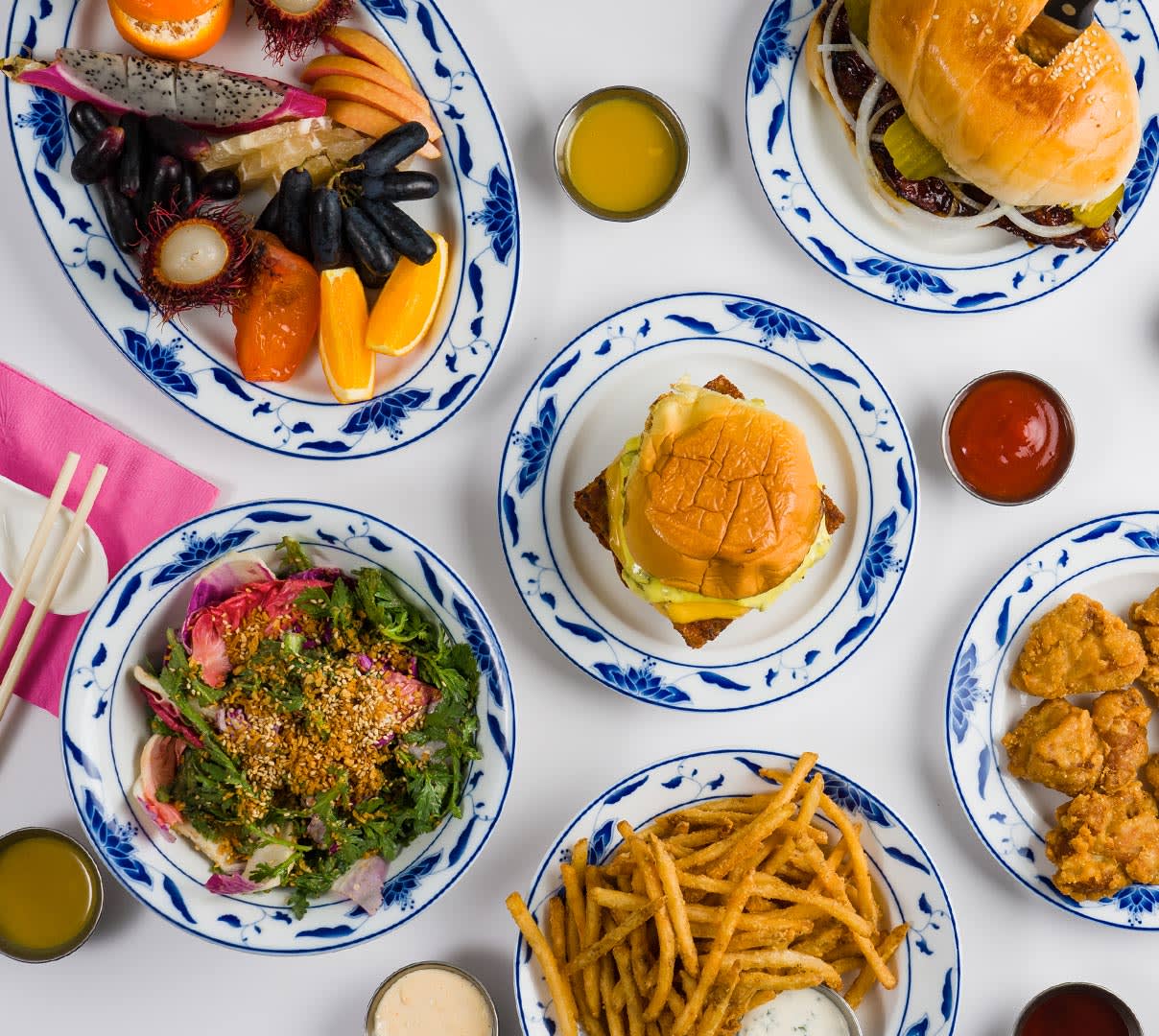Chow mein, steamed barbecue pork buns, and sweet-and-sour chicken. If Cantonese-inspired dishes like these come to mind when you think of Chinese American food, you're not alone. That’s because in the early 20th century, Cantonese restaurants in the U.S. soared in number when Chinese immigrants, many from the Guangdong province, had little choice but to find work in kitchens. The 1882 Chinese Exclusion Act had prohibited Chinese laborers from becoming U.S. citizens and made it difficult for those who had been in the U.S. to return after visiting home. In 1915, however, a legal loophole granted exceptions to immigrants who worked in certain businesses, including restaurants. So, between 1910 and 1930, the number of Chinese restaurants in the U.S. multiplied exponentially — and the vast majority of them were Cantonese.
Diners can now find a wide array of regional Chinese food in major cities across the country, of course, including Taiwanese, Hunan, and Xinjiang cuisines. In fact, spicy Sichuan and Taiwanese cuisines may have overshadowed the dim sum and barbecue that, for a long time, dominated the Chinese American–restaurant landscape. But Cantonese food is returning to the spotlight.
“There are so many of us who were born here [in the U.S.] and come from a deep line of Cantonese,” says chef Chris Cheung, chef and owner of Brooklyn’s East Wind Snack Shop, whose grandparents immigrated from the Taishan region of Guangdong province to New York in the 1920s. “I’m super amazed that this is coming full circle in such a short period of time.”

When Cheung says “this,” what he means is the renaissance of Cantonese cuisine playing out all over the country, from his place East Wind and Bonnie's in Brooklyn to Lazy Susan in the Bay Area. Momentum for this rise in reimagined Cantonese American food has been building for years as second- and third-generation immigrants have reached an age where they can take the reins and put their own spins on traditional family recipes and the restaurants in which they grew up. Their twists on the classics might look a little different than the Chinese American food you grew up with, but that’s just the point.
Cheung grew up in Manhattan’s Chinatown and Brooklyn’s Bensonhurst neighborhoods, where Cantonese cooking was square one, but all sorts of other influences — American fast food, Italian American, and other Chinese cuisines — were just as present. He garnered national acclaim as a member of the opening staff at both Nobu and Jean-Georges and then returned to the food of his youth: He started cooking at an upscale Chinatown restaurant and eventually worked under a Hong Kong dim sum master.
All of this informs his culinary approach at East Wind, his unique tribute to the coffee shops underneath the tenement housing in Chinatown, where his grandparents lived. Cheung starts with traditional Cantonese recipes and considers how to innovate them. “Going back to the traditional recipes always humbles you,” he says. “I like to have one foot on each side, where I’m based in the traditional recipes, but I remember that food has to evolve.”
Take his har gow, or crystal shrimp dumplings, a ubiquitous and delicate dumpling. At East Wind, Cheung’s dumpling filling is made almost entirely of shrimp, with some bamboo shoots mixed in for texture, but he takes this dish further by throwing a tapioca flour slurry into the pan to create a crispy coating — the subtle but important crunch that Cheung loves in a dumpling. His family was initially dubious, he admits, but now they love his signature take.
That innovation also is evident at Bonnie's in Brooklyn. It’s hard to snag a table at this buzzy restaurant, which has been called "rollicking" and the "new kid who throws the best parties," but luckily you can order the char siu “McRib” and red bean curd–marinated chicken nuggets with sweet-and-sour sauce for delivery. Bonnie’s, headed up by Calvin Eng, has earned national recognition for its celebratory vibes and excellent Cantonese American dishes.

Then there’s Nom Wah Tea Parlor Manhattan Chinatown’s oldest continuously running restaurant that now has a Nolita location and another in Philadelphia Owner Wilson Tang maintains the original look, feel, and recipes of the dim sum joint that opened in 1920 and has been in his family since 1975. He hasn’t shied, though, from innovation and personal touches. The bacon XO sauce used on dumplings and turnip cakes? “It’s not something I think my parents would approve of,” says Barbara Leung, head of marketing and “chief dumpling officer,” with a laugh, “but it’s very familiar in terms of that umami taste.”
It’s not all about personal narrative, though. Restaurants also want to meet consumer trends, like the ever-growing interest in plant-based eating, cocktails, and delivery.
“If you take a look at any other dim sum menu,” says Leung, “you usually see canned vegetables in dumplings.” Uninspired by traditional vegetarian fillings, Nom Wah developed one with edamame, straw mushrooms, and Chinese chives for more texture and protein.

The same plant-based focus shows up in the many vegan and vegetarian options at Lazy Susan, a delivery-centric, budding Chinese restaurant chain in the Bay Area that’s seen significant growth since it launched just before the pandemic. Though Lazy Susan isn’t strictly Cantonese American, cofounder Hanson Li, who was born in Hong Kong and grew up around Cantonese food there and when he moved to Rochester, New York, embraces American Chinese food’s distinct identity.
“I look at America as a region of Chinese cooking,” he says, contemporary food trends and all. For Li, that means making sure Lazy Susan offers plenty of gluten-free options in addition to the plant-based ones, and it also means upping delivery standards to meet consumer expectations. When the kitchen tests a dish at the restaurant, they don’t even taste it until after it’s sat in a box for 30 minutes. They cook broccoli on the crispier side, use slightly thicker noodles for their chow mein that will hold up in transit, and utilize special vented takeout containers to maximize the crispiness of certain dishes like General Tso’s chicken and orange chicken. Though steaming is a quintessential Cantonese cooking method, Lazy Susan opts for faster techniques like wok cooking — also classically Cantonese. They also marinate proteins ahead of cooking to imbue more flavor, requiring less sauce in finished dishes. “Many people have derided the cuisine we cook as inauthentic, but these are the classics we grew up getting in Chinese takeout, so we are honoring the cuisine that was popularized in the U.S,” Li says.
When it comes to in-person dining, restaurants are also answering the post-pandemic craving for that party vibe that Bonnie’s captures so well. At Washington, D.C.’s Tiger Fork, that plays out in a special cocktail list based on traditional Chinese medicine, a lively communal dining table, and the soon-to-return Night Market parties featuring guest chefs and DJs. Embracing both Chinese and American holiday traditions, Tiger Fork also plans to host a large Chinese New Year celebration and, for diners at home, to cater a festive Christmas and Christmas Eve menu.
Instead of drawing inspiration directly from U.S. Chinatowns, Tiger Fork channels Hong Kong’s street-food culture and the way Cantonese cooking manifested there. Bringing another unique interpretation to what Cantonese American food means, Tiger Fork leans on local ingredients, like using peaches in their hoisin sauce, and flips the script by using Chinese ingredients in American mainstays.
What all of these varied approaches confirm is that there’s no wrong way to do Cantonese American food. As Leung puts it, “It’s exciting to finally see that we're not cooking Cantonese food to satisfy what you think Cantonese is; we’re cooking Cantonese to really talk about how our identity travels — through what our moms made to what we enjoy eating and what is a contemporary representation of the identity that we have now.”






